Purple Flower Garden: Create a Stunning Garden with Vibrant Purple Blooms

Q1: What are sunflower companion plants?
A: Sunflower companion plants are crops or flowers that grow well alongside sunflowers. They either benefit from the sunflower’s height, attract pollinators, or help repel pests. Examples include cucumbers, beans, marigolds, garlic, and squash. These best companion plants for sunflowers help create a healthier, more balanced vegetable garden.
Q2: Why should I plant sunflowers with companion plants?
A: Companion planting helps sunflowers grow stronger while improving your garden’s ecosystem. Some plants, like beans, fix nitrogen into the soil. Others, like onions and garlic, naturally repel harmful insects. Together, these sunflower companion plants enhance soil health, attract bees, and keep your garden pest-free — without chemicals!
Q3: What plants should I avoid planting with sunflowers?
A: Some plants don’t mix well with sunflowers. Avoid:
- Potatoes – attract the same pests as sunflowers.
- Pole Beans – compete for sunlight and space.
- Fennel and other allelopathic plants – release chemicals that inhibit growth.
- Basil and parsley – struggle with too much heat and shade.
These are plants to avoid because they can harm your sunflower plant’s growth or attract unwanted pests.
Q4: What does “allelopathic” mean in gardening?
A: The term allelopathic refers to plants that release natural chemicals (called allelochemicals) into the soil or air that affect nearby plant growth. For example, fennel and black walnut trees are allelopathic plants — they can stunt the growth of sensitive neighbors like sunflowers or beans. Always research before planting them together.
Q5: Can I plant sunflowers in a vegetable garden?
A: Yes! Sunflowers in vegetable gardens are fantastic companions. They attract pollinators that improve fruit yields for vegetables like tomatoes, cucumbers, squash, and beans. Their tall stalks also act as windbreaks, protecting smaller crops from damage. Just remember to plant sunflowers on the north side so they don’t block sunlight from shorter plants.
Q6: How close should I plant companion plants to sunflowers?
A: It depends on the type of companion plant:
- Small herbs or root crops (carrots, onions, garlic): 6–8 inches away.
- Medium crops (beans, cucumbers): 12–18 inches away.
- Large crops (tomatoes, squash, corn): 2–3 feet away.
This spacing ensures good airflow and prevents allelopathic effects between plants.
Q: What are the most common pests that affect dieffenbachia?
A: Like many tropical houseplants, dumb cane can attract common pests such as spider mites, mealybugs, and scale insects. Regularly inspect leaves and treat infestations with neem oil or insecticidal soap.
Q: How do I fix common problems like yellowing leaves?
A: Yellow leaves usually mean overwatering, while drooping may indicate underwatering. Adjust your watering schedule and check soil moisture to resolve these common problems.
Q: Can I propagate dumb cane easily?
A: Yes! You can propagate dieffenbachia from stem cuttings placed in water or soil. Within weeks, new roots will form, giving you new plants to enjoy.
Q: How often should I repot my dieffenbachia?
A: Most dieffenbachias benefit from a fresh pot every 2–3 years, or sooner if roots start circling. Repotting not only gives them more space but also refreshes soil nutrients.
Q: Why is the Dieffenbachia plant also known as dumb cane?
A: Dieffenbachia is also known as dumb cane because its sap contains calcium oxalate crystals, which can cause temporary swelling and numbness in the mouth if ingested, making it difficult to speak.
Q: Why do the large leaves droop?
A: Drooping leaves may mean your plant is thirsty, overwatered, or suffering from cold drafts. Always check soil moisture first. If the soil is soggy, repot into fresh soil with better drainage.
Q: Can I remove older leaves from my dumb cane?
A: Yes, removing older leaves that are yellow or damaged helps redirect the plant’s energy to new leaves. Always prune with clean scissors and avoid cutting too close to the main stem.
Q: Can dieffenbachia plants grow quite large?
A: Yes, given the right conditions, a dieffenbachia plant may grow quite large—up to 6 feet indoors and even taller in tropical climates. Regular pruning helps control its size and shape.
Q: What are the ideal growing conditions for cauliflower?
A: Cauliflower grows best in cool weather with temperatures between 60–70°F. It prefers a garden bed with fertile, well-drained soil, a pH of 6.0–7.0, and consistent moisture. Because cauliflower is more sensitive than other vegetable plants, it struggles in the heat of summer and thrives in spring and fall.
Q: Is cauliflower difficult to grow compared to other vegetables?
A: Yes, cauliflower is considered one of the more difficult to grow garden vegetables. Unlike broccoli and cauliflower’s other Brassica relatives, cauliflower is more sensitive to temperature swings, soil fertility, and watering. With careful timing and steady care, though, you can get excellent results.
Q: When should I start cauliflower seeds?
A: For a spring harvest, start cauliflower seeds indoors 4–6 weeks before the last expected frost. For a fall harvest, start cauliflower 6–8 weeks before the first fall frost date. Cauliflower is best started indoors as seedlings rather than direct sowing, since it needs steady growth without setbacks.
Q: How big should heads of cauliflower be before harvest?
A: Heads of cauliflower, also called cauliflower curds, are ready to harvest when they grow to 6 to 8 inches in diameter. Some cultivars may reach 8 inches in diameter or more, but it’s best not to wait too long or the curds will loosen and lose flavor.
Q: How many days does it take cauliflower to grow?
A: Depending on the cauliflower cultivars you choose, the time to grow from seed to harvest is usually 55–100 days. Spring-planted cauliflower matures faster, while fall crops may take longer but often produce tighter, better-quality heads.
A purple flower garden brings a sense of elegance, mystery, and tranquility to any outdoor space. Whether you're dreaming of a peaceful retreat or a bold floral statement, incorporating vibrant purple blooms is a timeless way to transform your landscape. From the soothing hues of lavender to the rich tones of salvia and iris, purple flowers offer year-round beauty and visual depth. In this guide, we’ll explore inspiring ideas and practical tips to help you create a stunning purple flower garden that not only turns heads but also flourishes season after season. Let’s dive into the magic of purple blooms and discover how to design a garden that’s as captivating as it is colorful.
10 Purple Flower Varieties

1. Lavender (Lavandula angustifolia)
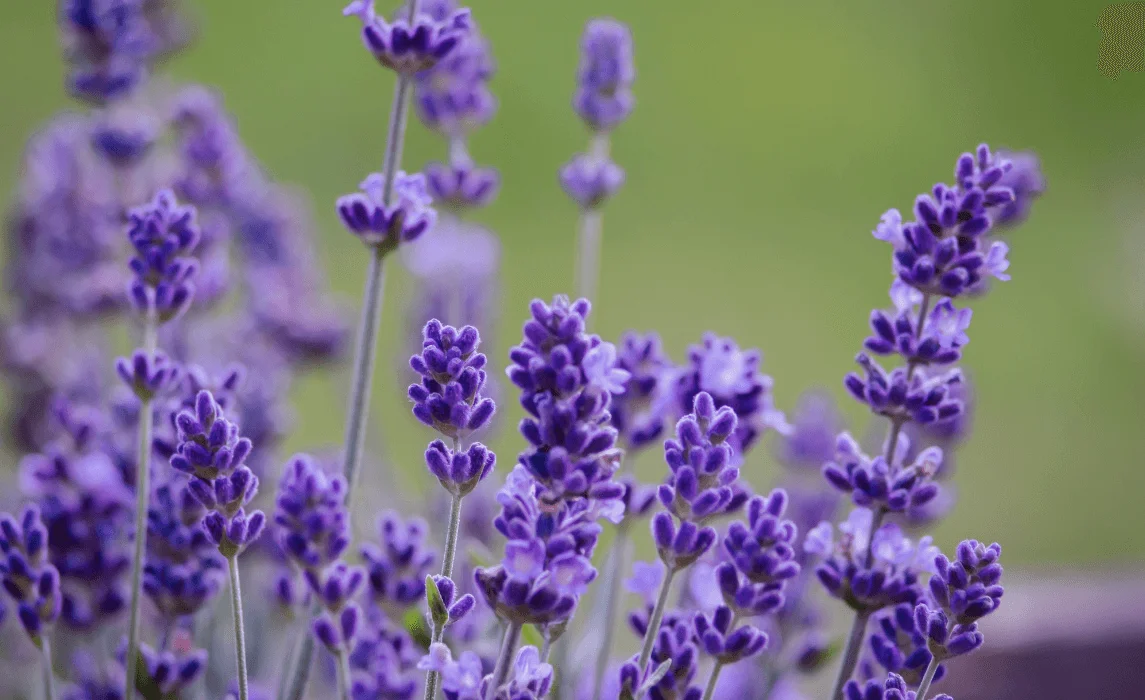
Lavender has been a beloved favorite in herb and flower gardens for centuries, known for both its stunning appearance and calming scent. Originally from the Mediterranean, this plant thrives in hot, dry regions and has become a staple in cottage-style gardens worldwide. Its upright, narrow gray-green leaves provide a silvery contrast to its signature purple flower spikes, which bloom in late spring through summer. Lavender reaches about 1 to 3 feet in height and produces dense, fragrant flower clusters that are a magnet for bees and butterflies.
To help lavender thrive, plant it in well-drained sandy soil with full sun exposure. It’s drought-tolerant once established and benefits from minimal watering. Prune back after flowering to maintain shape and promote new growth. Due to its low-maintenance nature and resilience in dry climates, lavender is ideal for beginner gardeners or anyone cultivating a drought-tolerant or Mediterranean-inspired landscape.
Soil: Sandy, very well-drained
Water: Low once established
Light: Full sun
Humidity: Low to moderate
Fertilizer: Minimal; compost in spring
Temperature: Warm; dislikes humidity
USDA Zone: 5–9
2. Purple Coneflower (Echinacea purpurea)

With its daisy-like shape and prominent spiny cone, the purple coneflower is an icon of North American prairies. This perennial is not only beautiful but also functional, known for its immune-boosting properties and its ability to support pollinators. Growing up to 2 to 4 feet tall, it produces rosy-purple petals surrounding a bold coppery-orange center. The rough, dark green leaves provide structural contrast to its floral display.
Purple coneflower does well in sunny garden beds, requiring well-drained soil and moderate water. It tolerates drought well after its first year and can thrive in both poor and rich soil. Remove faded flowers to encourage prolonged blooming. This tough yet elegant plant is perfect for beginner gardeners, wildlife gardeners, and anyone seeking long-lasting summer color.
Soil: Well-drained, average fertility
Water: Moderate initially; low when established
Light: Full sun
Humidity: Tolerant of most levels
Fertilizer: Compost or balanced fertilizer in spring
Temperature: Cold and heat tolerant
USDA Zone: 3–9
3. Salvia (Salvia nemorosa 'Caradonna')

Salvia is another perennial powerhouse that brings structure and vivid color to any garden. The ‘Caradonna’ variety stands out with its deep purple flower spikes rising above dark green to purple-tinted foliage. Native to Central Europe and West Asia, this hardy plant grows about 18–24 inches tall and blooms from late spring through early fall with frequent deadheading.
Thriving in full sun and well-drained soil, salvia enjoys hot, dry summers and resents being overwatered. Once established, it is drought-tolerant and low-maintenance. Bees, butterflies, and hummingbirds love it, making it a great option for pollinator gardens. Salvia suits intermediate to advanced gardeners who want continuous blooms without a lot of effort.
Soil: Light, well-drained soil
Water: Low to moderate
Light: Full sun
Humidity: Low to moderate
Fertilizer: Light spring feeding
Temperature: Cold hardy and heat tolerant
USDA Zone: 4–9
4. Verbena (Verbena bonariensis)
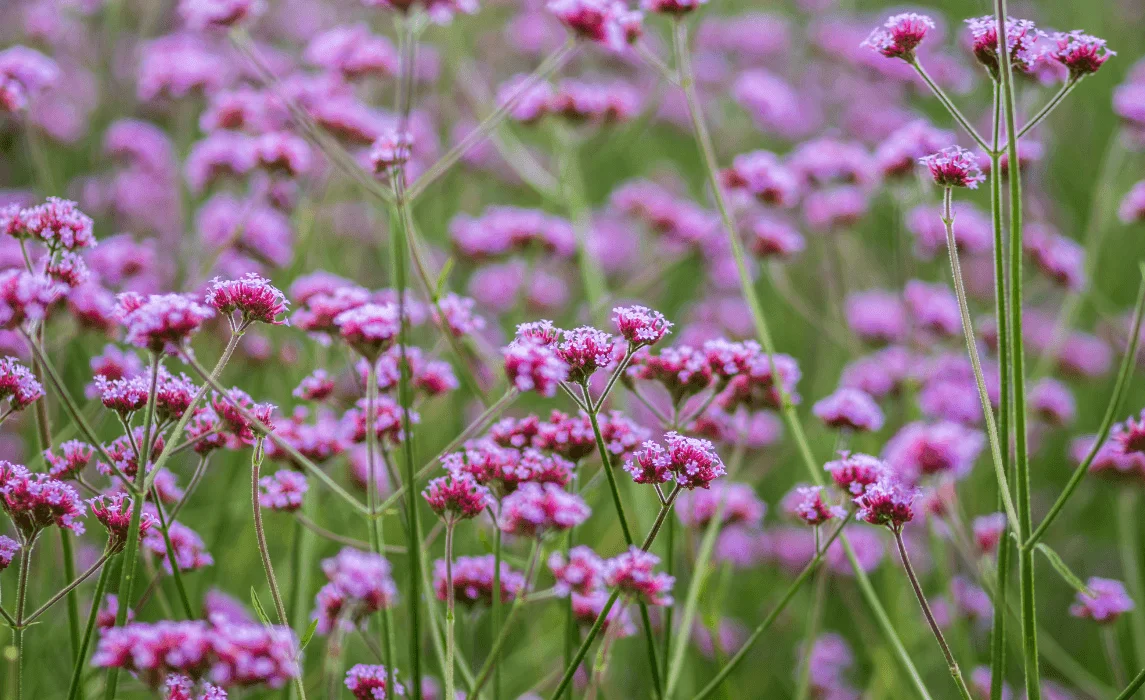
Native to South America, Verbena bonariensis is known for its tall, wiry stems and clusters of small purple flowers that seem to float above the garden. Reaching up to 4 feet tall, this see-through perennial adds an airy effect without crowding other plants. The flowers bloom from summer to fall and attract a host of butterflies and bees.
Verbena prefers full sun and tolerates drought well, especially once it's established. It thrives in loamy, well-draining soil and benefits from occasional deadheading to prolong blooming. Gardeners who love naturalistic or pollinator-friendly gardens will find this plant ideal. It works well in wildflower gardens, borders, and containers.
Soil: Loamy and well-drained
Water: Moderate, especially in dry periods
Light: Full sun
Humidity: Moderate
Fertilizer: Balanced fertilizer in spring
Temperature: Heat tolerant; can be overwintered indoors in cold climates
USDA Zone: 7–11 (as perennial); 3–6 (as annual)
5. Bellflower (Campanula carpatica)

Bellflowers are beloved for their cheerful, cup-shaped blooms that resemble tiny bells. Originating in Europe, Campanula carpatica is a low-growing perennial that forms dense mounds covered in soft purple or blue flowers from late spring to early summer. It typically grows up to 12 inches tall, making it ideal for rock gardens and borders.
They prefer cooler climates and perform best in well-drained, slightly acidic to neutral soil. Provide regular water, especially in warmer months, and partial sun in hotter zones. Ideal for beginner to intermediate gardeners, especially those with smaller spaces or who enjoy classic cottage-garden charm.
Soil: Well-drained, slightly acidic
Water: Moderate
Light: Full sun to part shade
Humidity: Prefers cooler, less humid areas
Fertilizer: Low nitrogen fertilizer in spring
Temperature: Cool temperate climates
USDA Zone: 3–8
6. Allium (Allium giganteum)
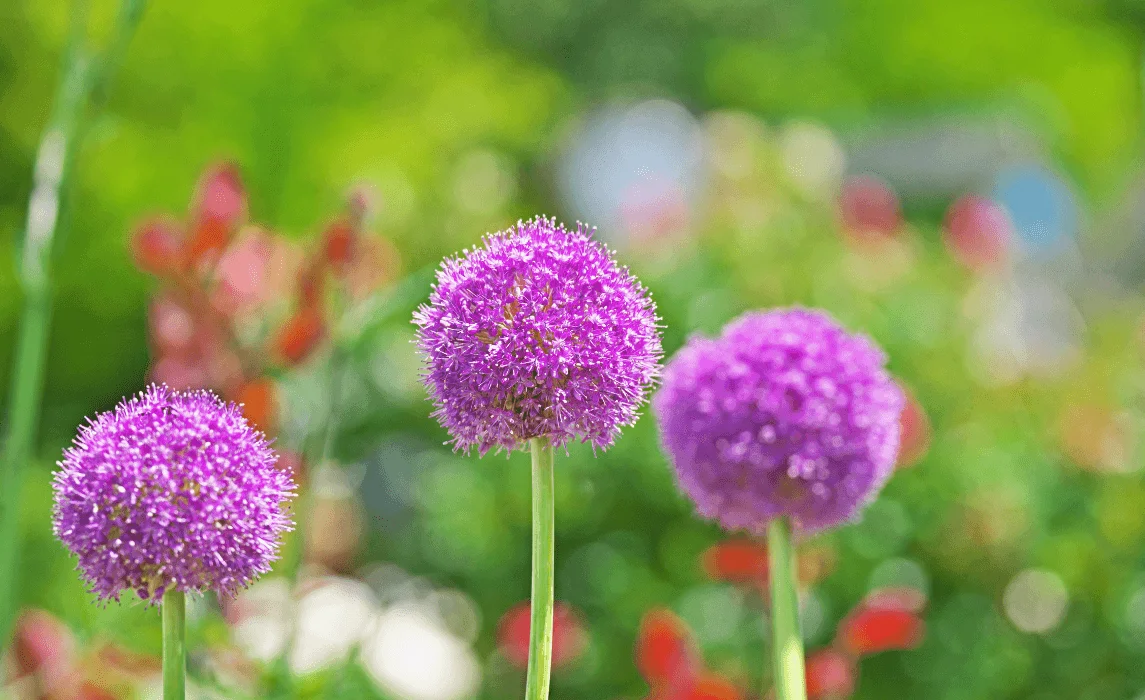
Alliums are striking bulbous perennials known for their globe-like flower heads. Allium giganteum, one of the tallest varieties, sends up 3–5 foot stalks topped with massive round purple flower clusters in late spring to early summer. The basal green leaves die back as the flowers emerge, which creates a clean and architectural look.
Plant bulbs in fall in full sun with well-drained soil. Alliums need minimal care and little water once established. They’re ideal for gardeners who want bold, sculptural interest in mixed borders or who enjoy creating dried arrangements. They're also deer- and rodent-resistant.
Soil: Sandy or loamy, well-drained
Water: Low; water only during dry spells
Light: Full sun
Humidity: Low to moderate
Fertilizer: Light compost when planting bulbs
Temperature: Cold-hardy
USDA Zone: 4–9
7. Morning Glory (Ipomoea purpurea)
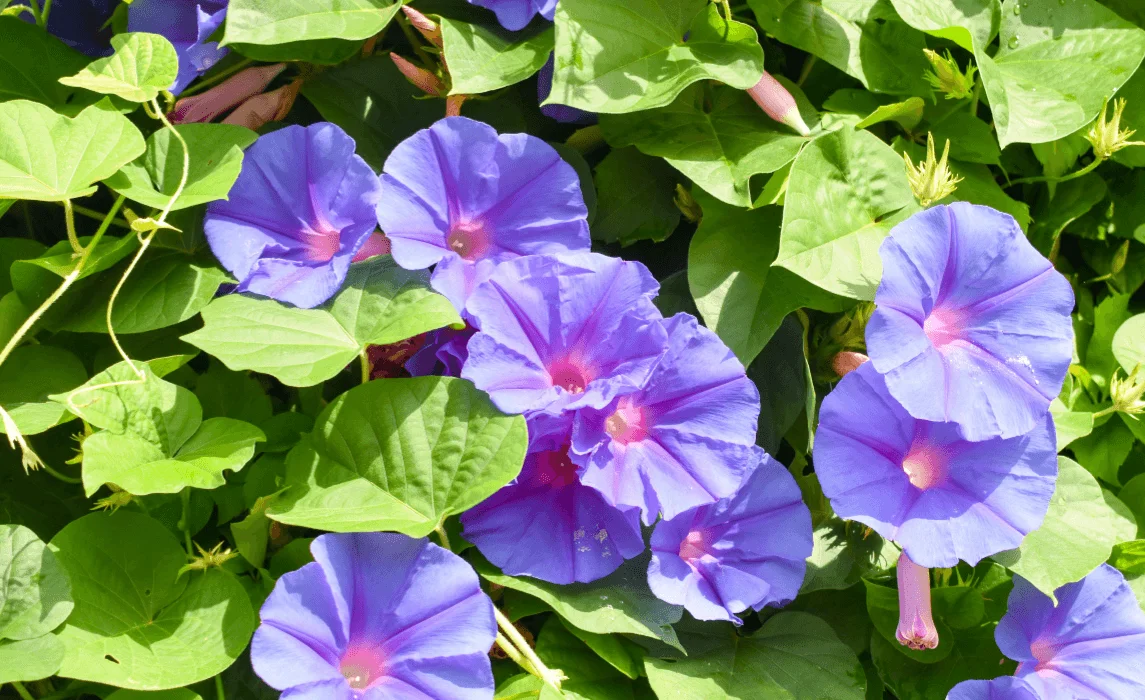
Morning glories are fast-growing annual vines admired for their trumpet-shaped flowers that unfurl with the sun. Native to Central America and Mexico, Ipomoea purpurea can climb up to 10 feet high, with vibrant purple flowers and heart-shaped green leaves. It adds vertical interest to fences, trellises, and walls.
This annual thrives in full sun and moist, well-drained soil. Morning glories are best suited for gardeners who want quick, vibrant blooms and don’t mind reseeding them annually. Keep soil evenly moist but not soggy, and plant where they get morning sunlight.
Soil: Moist but well-drained
Water: Moderate
Light: Full sun
Humidity: Moderate to high
Fertilizer: Minimal; avoid high-nitrogen fertilizers
Temperature: Warm-season annual
USDA Zone: Grown as annual in all zones
8. Clematis (Clematis viticella)
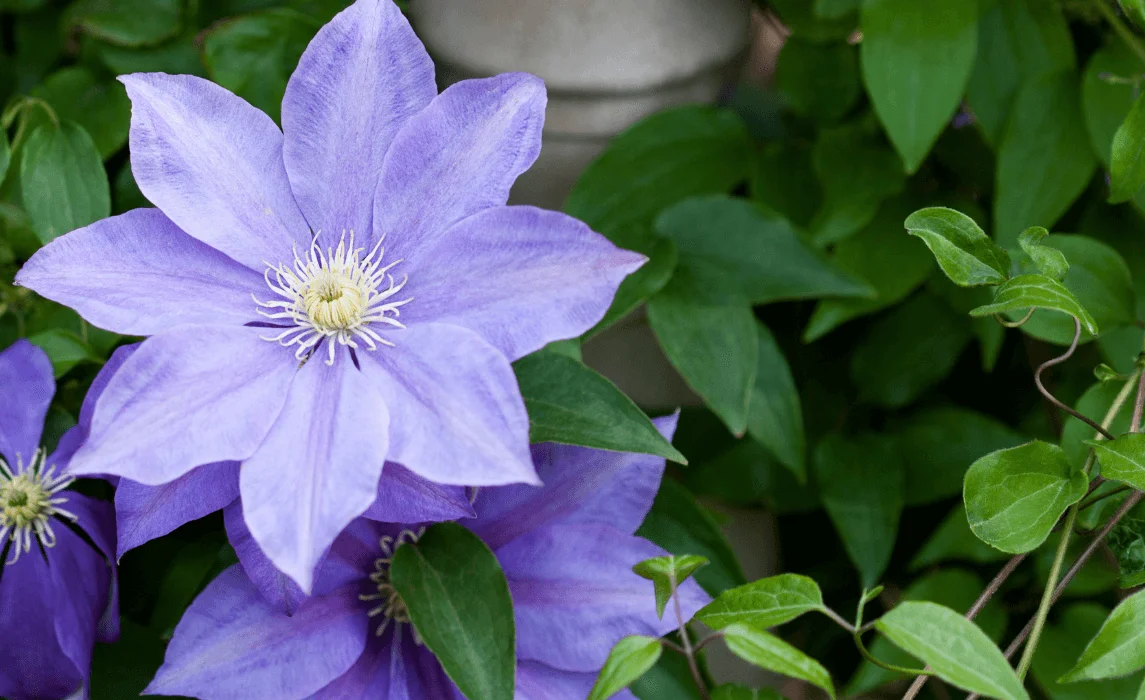
Clematis viticella is a vigorous climber known for its abundance of bell-shaped or star-like purple flowers, blooming from summer to fall. Originally from southern Europe, it’s a hardy vine that can grow up to 10–12 feet with support, showcasing velvety blooms and delicate green leaves.
It thrives in full sun with its base shaded, and appreciates rich, well-drained soil. Regular watering and mulching help retain moisture. Clematis is best suited for intermediate to experienced gardeners due to its pruning needs, but it rewards with months of stunning blooms.
Soil: Rich, well-draining
Water: Moderate, consistent
Light: Full sun on top; shade at base
Humidity: Moderate
Fertilizer: Monthly feeding during bloom
Temperature: Hardy once established
USDA Zone: 4–9
9. Garden Phlox (Phlox paniculata)
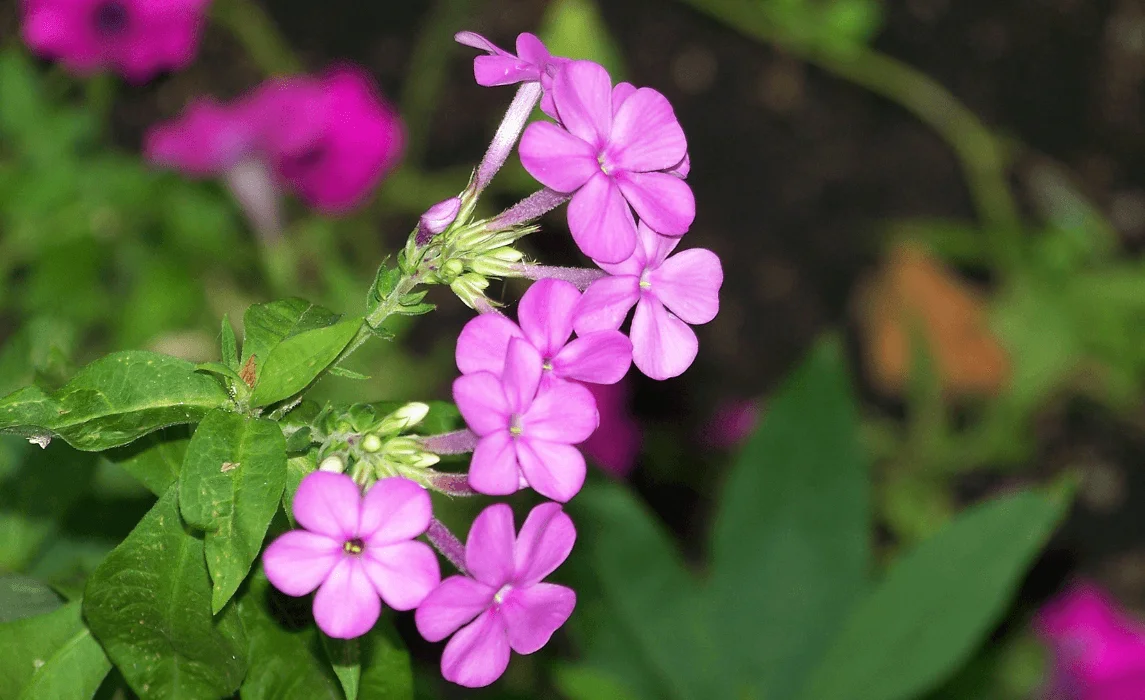
Garden Phlox brings classic beauty to summer gardens with fragrant clusters of star-shaped purple flowers. This North American native grows up to 3–4 feet tall with bright green foliage and large floral domes. It blooms from mid to late summer and pairs well with ornamental grasses and echinacea.
Phlox does best in full sun to light shade, in moist, well-drained soil. Water regularly, especially during heat waves, and provide good air circulation to prevent mildew. It suits gardeners who enjoy fragrant, long-blooming perennials with a cottage-garden appeal.
Soil: Rich, moist, well-drained
Water: Moderate to high
Light: Full sun to part shade
Humidity: Moderate
Fertilizer: Balanced in spring
Temperature: Prefers moderate climates
USDA Zone: 4–8
10. Catmint (Nepeta x faassenii)
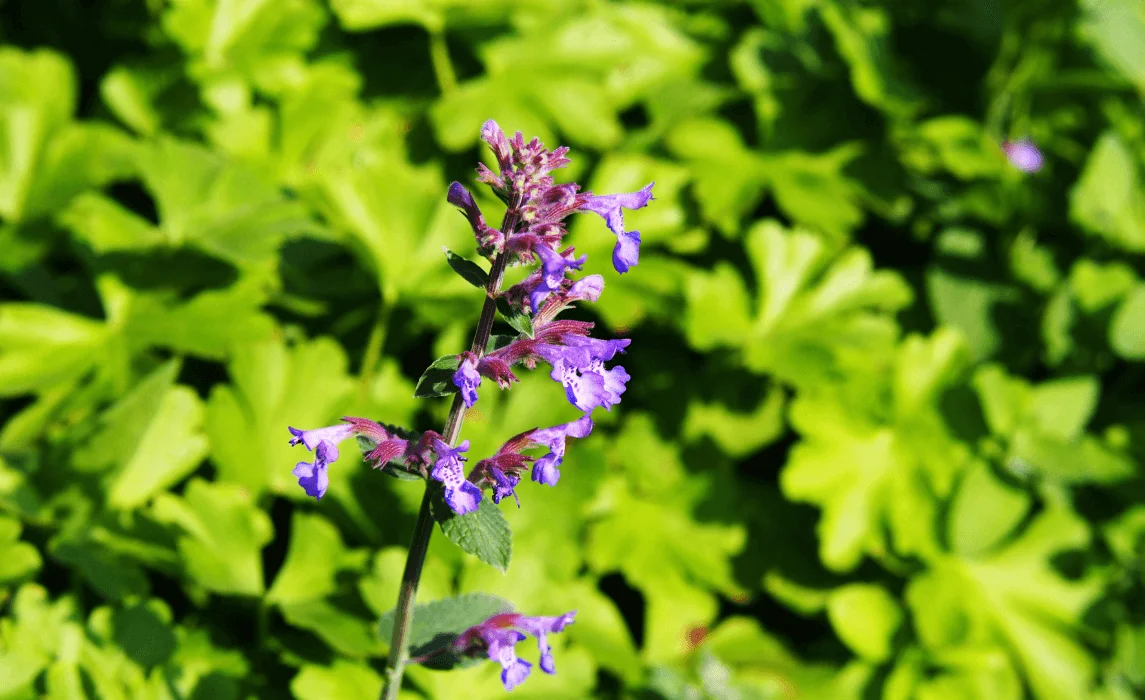
Catmint is a hardy, sprawling perennial that produces waves of small lavender-blue flowers from late spring through summer. Its soft, gray-green leaves emit a pleasant scent and form a mounded habit about 1–2 feet tall. It’s not only attractive to pollinators but also deer- and rabbit-resistant.
It prefers full sun and well-drained soil and thrives in dry conditions. Once established, catmint is virtually maintenance-free. Ideal for beginner gardeners and those in dry climates, catmint works well as a groundcover or in borders.
Soil: Well-drained, average
Water: Low
Light: Full sun
Humidity: Low to moderate
Fertilizer: Compost in spring
Temperature: Tolerates heat and cold
USDA Zone: 3–8
Frequently Asked Questions:
Q: Can I grow annual flowers in a purple garden alongside perennials?
A: Absolutely, mixing annual flowers with purple perennials adds variety and color through different seasons. Include petunias, morning glories (with trumpet-shaped flowers), or ageratum as bedding plants for summer color, while perennial favorites like garden phlox and purple coneflower return each year for flowers to grow over time.
Q: What are some purple flowers that bloom early in spring?
A: Some of the flowers from spring such as purple bulbs or tubers—think Iris (violet and blue-purple blooms) or early-blooming lavender-blue flowers—offer an early purple color kick. These types of purple flowers are one of the first flowers to appear and help set the tone for your spring garden.
Q: Which purple flowers are excellent for cut flower arrangements?
A: If you’re looking for excellent cut flowers, consider purple coneflower, garden phlox, lavender with purple flower spikes, or deep purple flowers like Allium. These varieties have sturdy stems, vibrant flower clusters, and lasting flower heads that hold up well in bouquets.
Q: How can I use purple foliage to enhance a garden's color palette?
A: Pair purple foliage plants such as Heuchera with green foliage for dramatic effect. Use them alongside plants with purple flowers or violet flowers so that the foliage complements the bloom colors. This contrast brings out richer tones in the flowers and helps the purple garden feel lush and cohesive.
Q: What purple flowers bloom late in the season?
A: For flowers from late summer to fall, Liatris, purple coneflower, and Verbena bonariensis offer long-lasting blooms and violet-blue flowers. These perennial flowers keep your garden vibrant well after the early bloomers fade, extending the season of interest.







